How Soviet troops liberated Novgorod
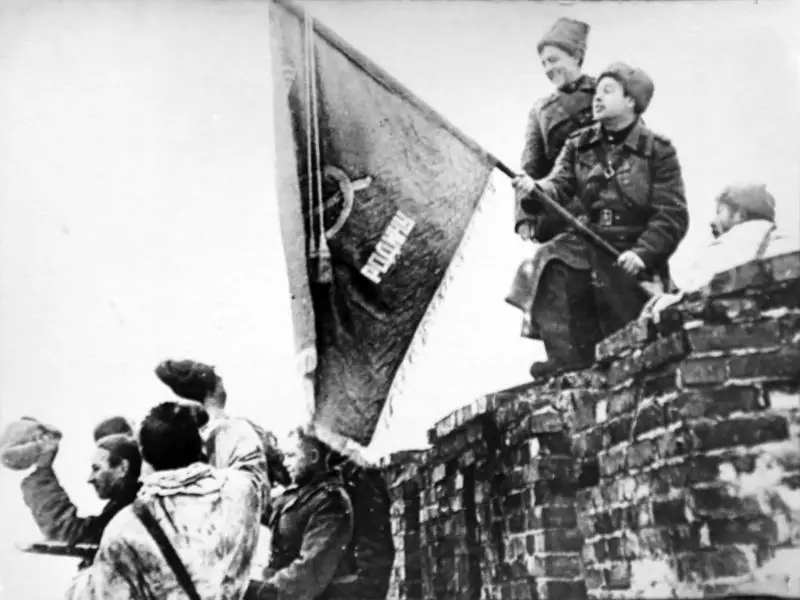
Soviet soldiers and commanders with a banner in liberated Novgorod. January 20, 1944
On January 20, 1944, troops of the Volkhov Front liberated Novgorod. The German army occupied the ancient Russian city in August 1941.
Fighting for the city took place from August 14 to 19, 1941, but it was not possible to defend it. Novgorod was under occupation for almost two and a half years, 29 months.
Novgorod-Luga offensive operation
The offensive of the troops of the Volkhov Front, launched simultaneously with the Krasnoselsko-Ropshinsky operation of the Leningrad Front ("January Thunder" How the German 18th Army was driven back from Leningrad), was part of the Leningrad-Novgorod strategic offensive operation. The Volkhov Front (VF) was given the task of defeating the Novgorod enemy group, liberating Novgorod and the Oktyabrskaya Railway and encircling, together with the troops of the Leningrad Front, the main forces of the German 18th Army in the Luga area.
The Military Council of the VF planned to carry out the operation in three stages. At the first stage, it was planned to break through the enemy’s defenses and liberate Novgorod, at the second stage - to advance 30 kilometers and reach Luga, at the third stage - having captured Luga, to develop an offensive on Pskov and Ostrov.
By the beginning of 1944, the VF occupied the line from Gontovaya Lipka to Lezno and further along the Volkhov River to Lake Ilmen, holding a bridgehead on the left bank of the Volkhov in the Dymno-Zvanki section.
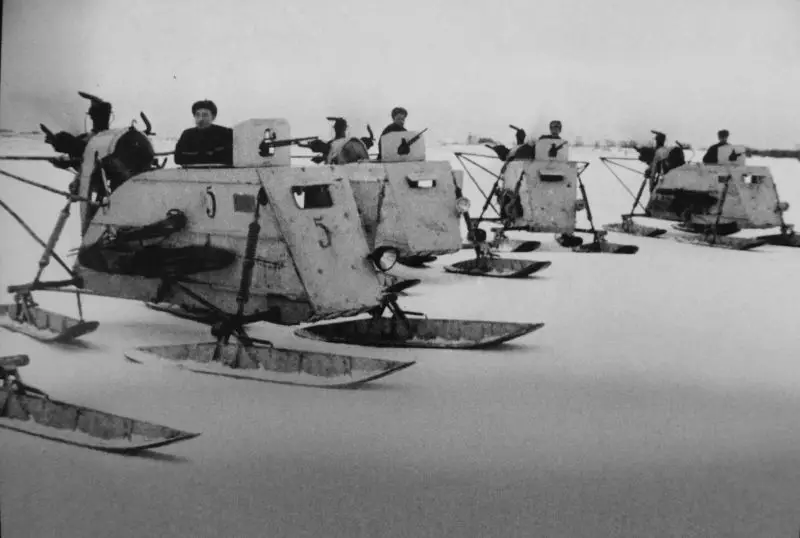
Snowmobile NKL-26 of the 44th separate snowmobile battalion before going on a combat mission south of Novgorod. The battalion was commanded by Captain M.A. Prokhatilov. For military services during the liberation of Novgorod, the battalion received the honorary name “Novgorod” on January 21.01.1944, 1944. January XNUMX
On January 14, 1944, simultaneously with the troops of the LF, the 59th Army of the VF went on the offensive. The 59th Army under the command of General Korovnikov received the task of defeating the German group in the Novgorod region and liberating Novgorod and the Oktyabrskaya Railway. The army struck with the forces of two groups in directions converging on Lyuboliady. The main forces advanced from a bridgehead on the left bank of the Volkhov, 30 kilometers north of Novgorod, and auxiliary forces - in the area of Lake Ilmen, south of Novgorod.
The 8th and 54th armies of the VF were supposed to distract the enemy in the Tosno and Lyuban directions so that the Germans could not transfer them to help the Novgorod group.
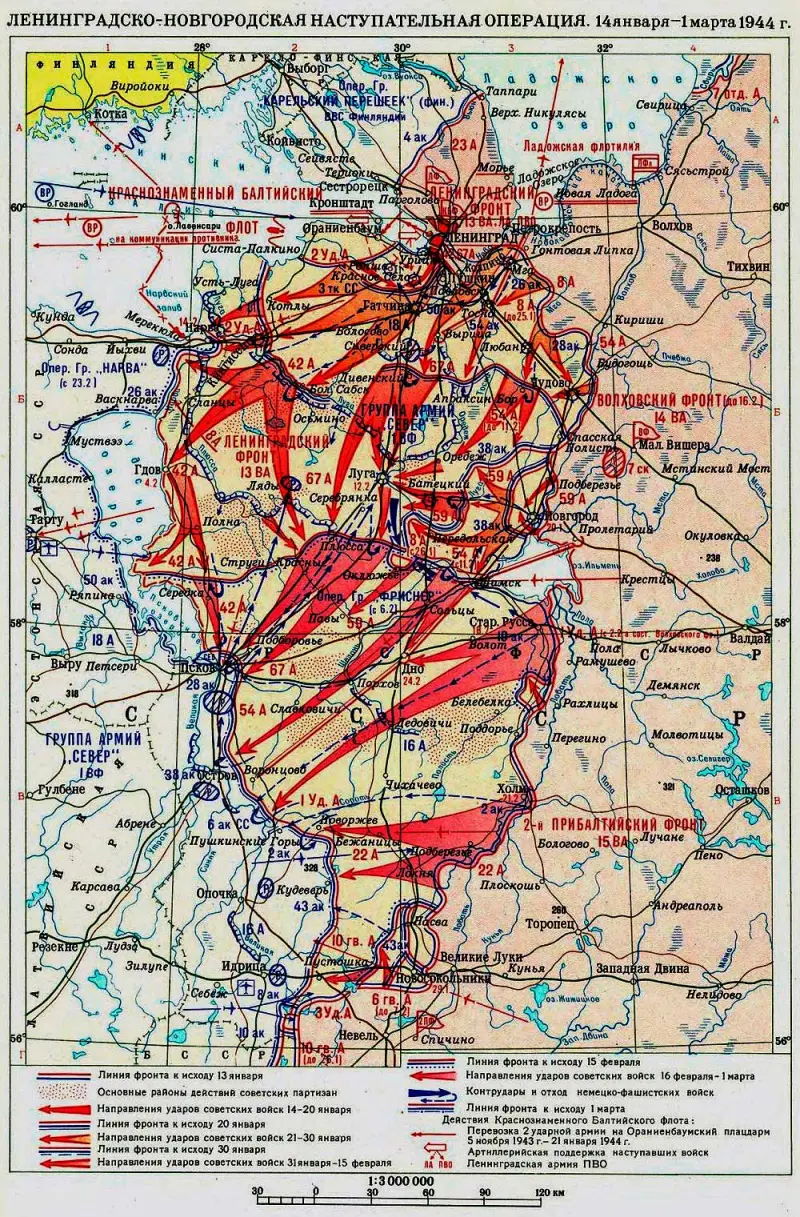
The forces of the parties
The VF was opposed by parts of the 38th, 26th and 28th Army Corps of the 18th German Army. A total of 6 infantry divisions and 2 infantry brigades, 3 air field divisions.
The Germans relied on a network of strong resistance centers, among which Novgorod, Chudovo, Lyuban, Tosno, Mga and Luga stood out. In the direction of the main attack of the Red Army, the Germans had two defensive lines: the main one along the Novgorod-Chudovo highway, the second along the Kerest River. Also, Novgorod itself was directly protected by three defensive lines. In the city, many stone buildings were turned into long-term firing points.
At the beginning of the operation, the VF numbered about 300 thousand people (according to other sources, about 260 thousand people). The 59th Army, which played the main role in the offensive, numbered about 135 thousand people, the 8th Army - 45 thousand people, the 54th Army - 67 thousand people, the 14th Air Army - more than 16 thousand people. More than 33 thousand people were in front-line formations. The VF had 3,6 thousand guns and mortars, about 400 tanks and self-propelled guns, over 250 aircraft.
Also, a large role in the upcoming offensive was assigned to the actions of partisan formations of the Leningrad region - in total about 35 thousand soldiers and commanders in 13 partisan brigades.
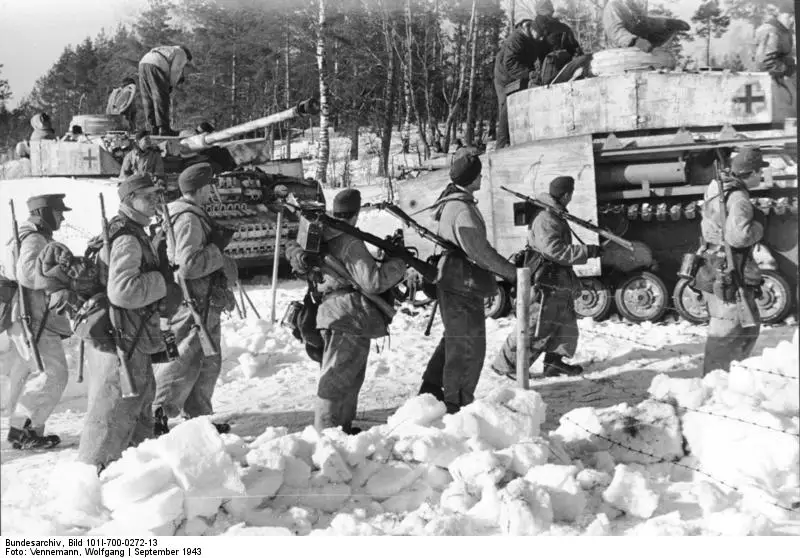 Army Group North, winter 1943–1944.
Army Group North, winter 1943–1944.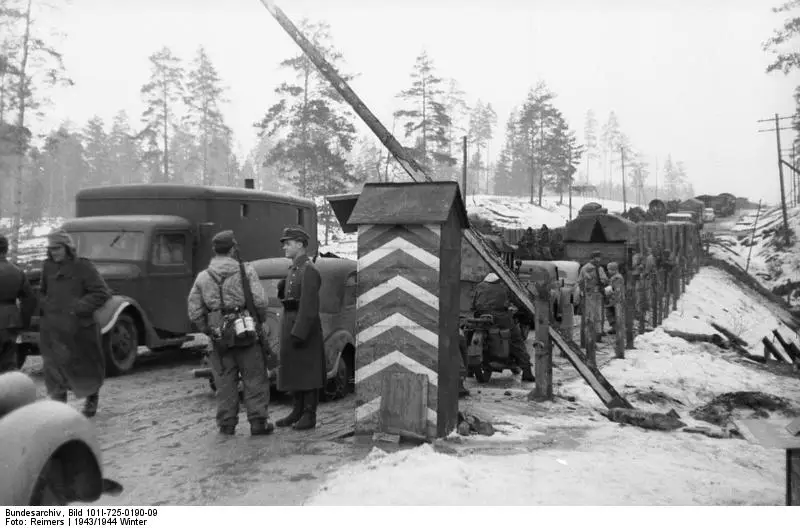
One of the roads between the Gulf of Finland and Lake Ilmen during the retreat of German troops, Army Group North, February 1944.
German defense breakthrough
On the first day of the offensive, Korovnikov's 59th Army did not achieve noticeable success. The Nazis, relying on a powerful defense, fought back fiercely and skillfully. In addition, snowfall and blizzard precluded support aviation, and artillery assistance turned out to be ineffective. The armored vehicles were stopped by the swamps. Soviet troops advanced only 600–1 meters.
The auxiliary, “southern group” of the 59th Army under the command of Major General Sviklin advanced more successfully. Soviet soldiers were able to cross the ice of Lake Ilmen at night and, with a surprise attack, captured a number of enemy strongholds and occupied a bridgehead.
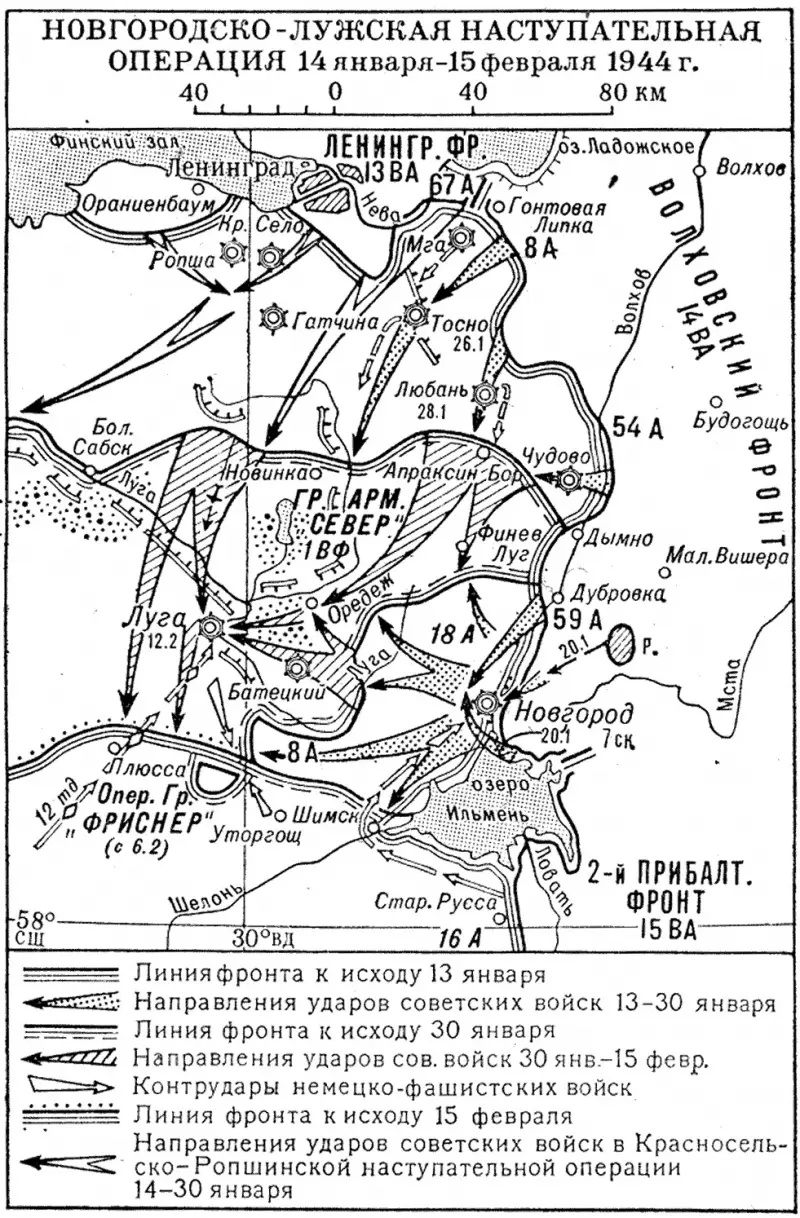
The German command, fearing encirclement of the Novgorod group, sent reinforcements to this area - units of the 290th and 24th infantry divisions and the Nord cavalry regiment.
The commander of the 59th Army, in order to increase the strength of the attacks, introduced additional forces from the second echelon in the northern and southern directions.
As a result of fierce fighting on January 15–16, the Red Army broke through the enemy's main defense line. The Novgorod-Chudovo railway was cut.
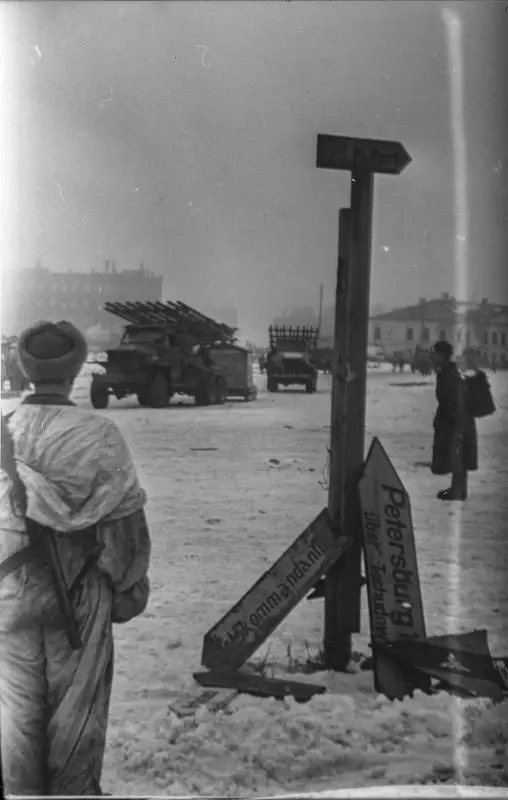
Guards BM-13 rocket mortars based on American Studebaker US6 trucks drive across the square in liberated Novgorod.
Liberation of Novgorod
In the following days, the troops of the 59th Army continued their slow advance. On January 18, the southern group cut the highway and railway Novgorod - Shimsk. On January 20, units of the northern group reached the Novgorod-Batetsky railway. The resistance of the German troops was strong, so the pace of the offensive was low - 5-6 km per day. It is also necessary to take into account the factor of off-road conditions and wooded and swampy terrain. This did not allow the Novgorod enemy group to be quickly encircled.
The German command retained the ability to maneuver reserves and transfer troops from unattacked sectors of the front. The Germans, in order to stabilize the front, transferred new troops - parts of the 21st, 121st Infantry and 8th Jaeger Divisions and some other units. But it was not possible to rectify the situation. To avoid encirclement of units of the 38th Army Corps, the commander of the 18th Army Lindeman gave the order to leave Novgorod. The Germans, abandoning their heavy weapons, retreated towards Batetsky.
On the morning of January 20, Soviet troops occupied Novgorod without a fight. Units of the 191st and 225th Rifle Divisions of the 14th Rifle Corps and the 382nd Rifle Division of the 7th Rifle Corps (from the front reserve) entered the city.
The German Novgorod group - parts of the 28th Jaeger, 1st Air Field Division and the SS Cavalry Regiment "Nord" - were unable to leave. On January 59, two groups of the 20th Soviet Army had already united 10 kilometers west of Novgorod in the Gorynev area. Having repelled all attempts to break out of the encirclement, as well as German attacks from outside the ring, parts of Korovnikov’s army, together with the 7th Rifle Corps from the front reserve, destroyed scattered enemy groups in the forests west of Novgorod.
The Soviet command estimated enemy losses in this area at over 15 thousand killed, 182 guns and 120 mortars were captured. About 3 thousand Germans were captured.
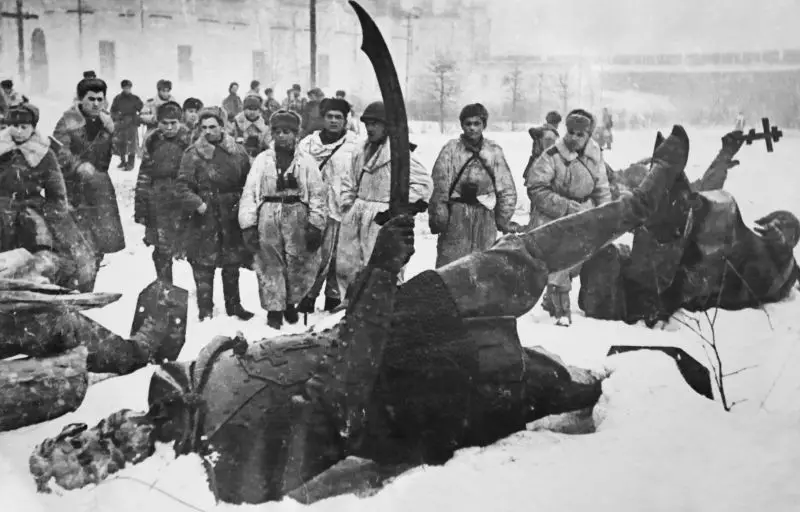
Soviet soldiers inspect fragments of the destroyed monument “Millennium of Russia” in liberated Novgorod. German General von Herzog ordered the “Millennium of Russia” monument to be dismantled and taken to Germany, intending to make a gift to a friend in his homeland. In the winter of 1943–1944, work was carried out to dismantle the monument. The Germans managed to take away by rail only the bronze lattice surrounding the monument, the work of Professor Bosse, as well as the lanterns that stood around the monument. The invaders were never able to remove the dismantled monument.
Offensive development
On January 16, 1944, the 54th Army under the command of Roginsky went on the offensive in the Chudovo-Luban direction. It pinned down units of the 26th and 28th German Army Corps. Fierce fighting raged for several days. Roginsky's army was able to advance only 5 km. The German command ordered to hold the area of Chudovo and Lyuban at any cost, since important communications passed here - the Oktyabrskaya Railway and the Leningrad-Moscow highway. The Mga group was retreating to this area; the intermediate defense line “Avtobahn” passed here.
On January 21, the 8th Army liberated Mgu. The retreat of German troops from the Mginsk-Sinyavinsky ledge forced the Soviet command to adjust their plans. The 67th Army of the Leningrad Front and the troops of the Volkhov Front received the task of liberating the area of the Oktyabrskaya Railway and Krasnogvardeysk. On January 22, the Military Council of the VF presented to Headquarters a plan for the development of the operation. Units of the 59th Army were to liberate Luga, and troops of the 8th and 54th Armies were to liberate the Tosno and Lyuban area. The 54th Army was strengthened by units of the 8th and 67th armies and front reserves.
Fierce fighting lasted for several days. Only on January 26, Soviet troops took Tosno, on January 28 they liberated Lyuban and on January 29 – Chudovo. The Oktyabrskaya Railway and Leningradskoe Highway were cleared of the enemy.
By the end of January, the VF troops, having overcome 60–100 km with heavy fighting, reached the Luga River. However, the German command was able to quickly strengthen its forces in the Luga area and gain a foothold at a previously prepared line. The Germans transferred the 12th Panzer Division here.
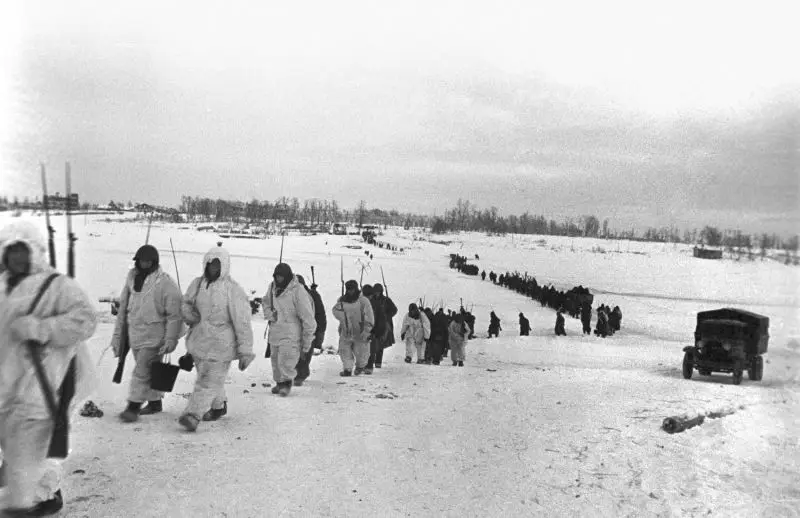
Soviet infantry advances to the front line during an offensive in the Novgorod area
On January 31, units of the 2 Shock Army of the Leningrad Front forced Luga and began storming Kingisepp. 1 February Kingisepp was released. Developing success, the army captured small bridgeheads on the left bank of the r. Narva. The 42 Army of the Leningrad Front reached the border of Luga by January 27. Having crossed the river, the army of February 1944 took Gdov and went out to Lake Peipsi.
The main task of the VF continued to be the liberation of Luga. The 59th and 8th armies attacked the city from the east, and the 54th army from the northeast. The Soviet offensive on Luga developed slowly.
The German command gathered all available forces and reserves of the 18th and 16th armies in the area of Pskov and Luga. The commander of Army Group North, Walter Model, gave the order to hold this area at any cost. Model was appointed commander of Army Group North on January 31, replacing Georg von Küchler, who began a general retreat despite Hitler's direct prohibition.
As a result, Soviet troops were able to liberate Luga only on February 12.
Due to the fact that the VF troops were unable to complete the task of capturing the Luga node of enemy resistance in time, the front was disbanded. On February 13, 1944, the Headquarters transferred the 54th, 59th and 8th armies to the Leningrad Front, the 1st Shock Army (it was part of the VF from February 2 to 15) to the 2nd Baltic Front. The front control was transferred to the reserve of the Supreme Command Headquarters.
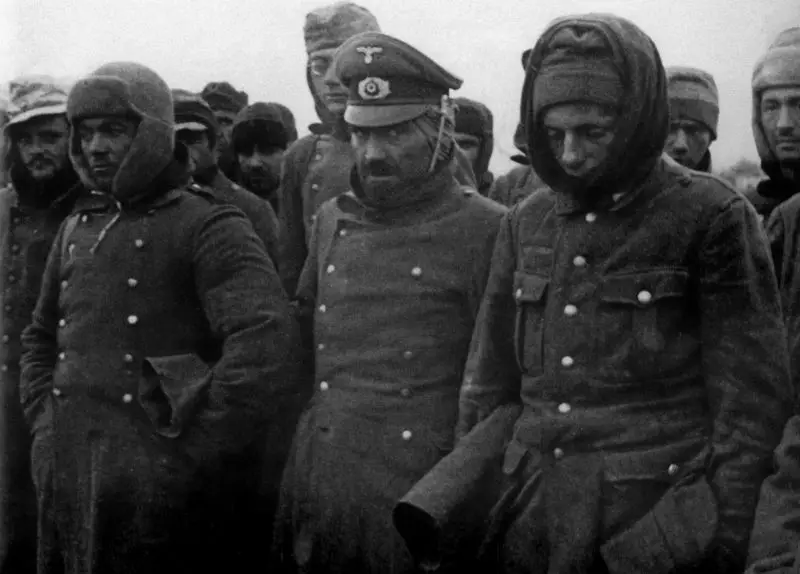
German captured soldiers and officers captured during the operation to break the blockade of Leningrad. Area of the village of Mga (Kirovsky district, Leningrad region). January 22, 1944
Results
During the Novgorod-Luga operation, Soviet troops won a victory, which largely predetermined the success of the entire Leningrad-Novgorod strategic offensive operation (the so-called First “Stalinist strike”). By February 15, the troops of the Volkhov Front and the LF army pushed the enemy back 50–120 km and reached the southern coast of Lake Peipsi. 779 cities and towns were liberated, including Novgorod and Luga. The liberation of such strategic communications as the Oktyabrskaya Railway and Leningradskoe Highway was of great importance.
German troops were unable to cling to the Luga line, establishing a new front line between the Ilmen and Peipsi lakes. The German command had to withdraw troops further, to the Panther line of defense.
But the Red Army’s offensive did not develop as rapidly as originally planned. It was not possible to capture Luga in a short time and only with the forces of the VF. To solve this problem it was necessary to attract the forces of the 42nd and 67th armies of the LF. This weakened the onslaught of the Leningrad Front in the Narva region. It was not possible to encircle and destroy large enemy forces.
The German 18th Army was defeated, but retained its combat effectiveness.
As a result, this did not allow the Soviet armies to defeat the main forces of Army Group North by the spring of 1944, break through the Panther Line and begin to liberate Estonia and Latvia.
The liberated territories were severely devastated by the German occupation. Thus, Novgorod was almost completely destroyed. Of the 2 residential buildings existing in Novgorod before the war, only 346 remained. Almost all industrial enterprises were destroyed, including a foundry, mechanical, ship repair, two brick factories: a tile factory and a sawmill. A shipyard, a railway depot, a meat processing plant, a bread plant, a shoe and furniture factory were also destroyed. The Nazis destroyed the city infrastructure: water supply, water and water pumping stations, telephone exchange, post office, telegraph, radio center and electrical facilities.
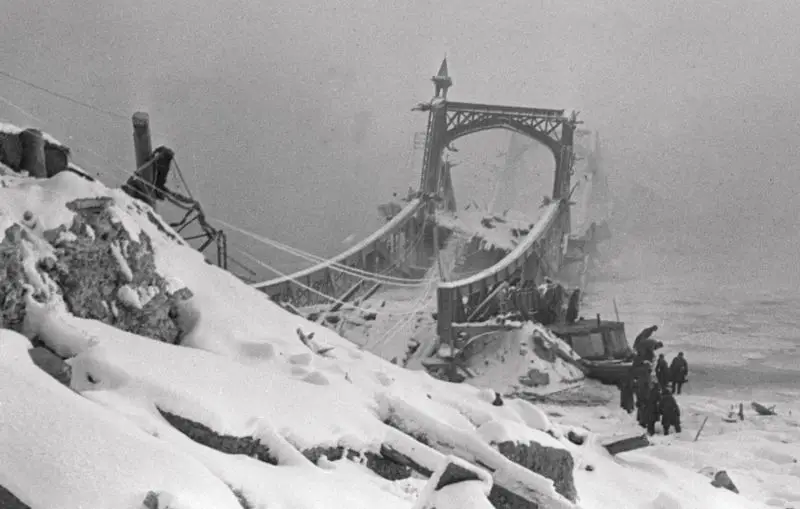
The bridge across the Volkhov in Novgorod blown up by German troops during the retreat
The Germans attacked scientific, educational and cultural institutions. Before the war, Veliky Novgorod was a major Soviet scientific and cultural center.
The Nazis destroyed the museum building and its art gallery; robbed a scientific library, a photo library containing rare data and a bibliographic card file of a branch of the Institute stories Academy of Sciences of the USSR; They burned a pedagogical institute, technical schools, a pedagogical school, medical schools, 3 hospitals, a maternity hospital, a children's clinic, the main building of a psychiatric hospital, the House of the Red Army, a city theater, 2 cinemas, 5 clubs, etc.
According to the data of the Extraordinary Commission on the atrocities of the fascist invaders, material damage to the city amounted to more than 11 billion rubles.
Many unique sights and monuments were completely destroyed or severely damaged. From the Novgorod museum, which was not evacuated in time, valuable collections on the history of archeology and art were stolen. The destruction and losses were so great that they became an irreparable loss of part of Russian national culture.
St. George's Cathedral, built at the beginning of the 12th century, was badly damaged. St. Sophia Cathedral, built in the 11th century and being one of the oldest monuments of Russian architecture, a treasure of Russian culture, which had frescoes and icons of the 12th century, was destroyed. The interior of the cathedral was looted.
The Church of the Annunciation on Arkazh of the 12th century, with frescoes of the same century, was turned into a pillbox and a barracks building. The church was badly damaged. The Church of the Assumption on Volotovo Field, a monument of northern Russian architecture of the 14th–15th centuries, was turned into a pile of rubble.
The Church of the Transfiguration on Ilyin Street, a monument of 14th-century Novgorod architecture, also famous for its paintings by the great master Theophan the Greek, was badly damaged. Most of the frescoes were destroyed, and the remaining ones were damaged.
The Church of the Savior-Nereditsa, a monument of ancient Russian art of the 12th century, famous for Byzantine and Russian painting, was barbarically destroyed.
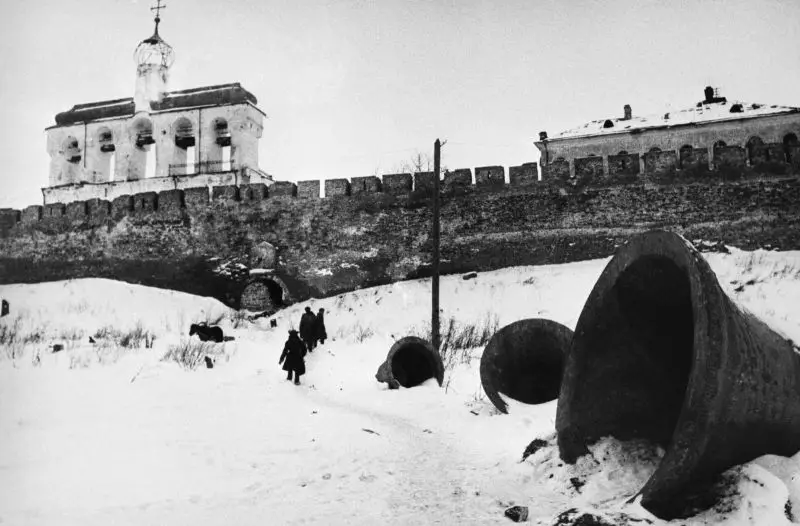
View of the belfry of the St. Sophia Cathedral with the bells removed in liberated Novgorod
The Novgorod Kremlin, its towers and internal structures were badly damaged. By order of the commander of the 18th German Army, Lindemann, the Nazis dismantled and prepared the monument to the 1000th anniversary of Russia for sending to the German Empire. The monument was dismantled, many unique sculptural images of the most prominent Russian state, military, public and cultural figures were destroyed.
The Soviet government paid special attention to the restoration of Veliky Novgorod. On November 1, 1945, the city was included in the list of fifteen settlements that were subject to priority restoration. Particular attention was paid to the restoration and restoration of historical monuments.
One of the first to be restored was the “Millennium of Russia” monument, erected in Veliky Novgorod in 1862 in honor of the millennium of Russian statehood. Already on November 5, 1944, the second grand opening of the monument took place.
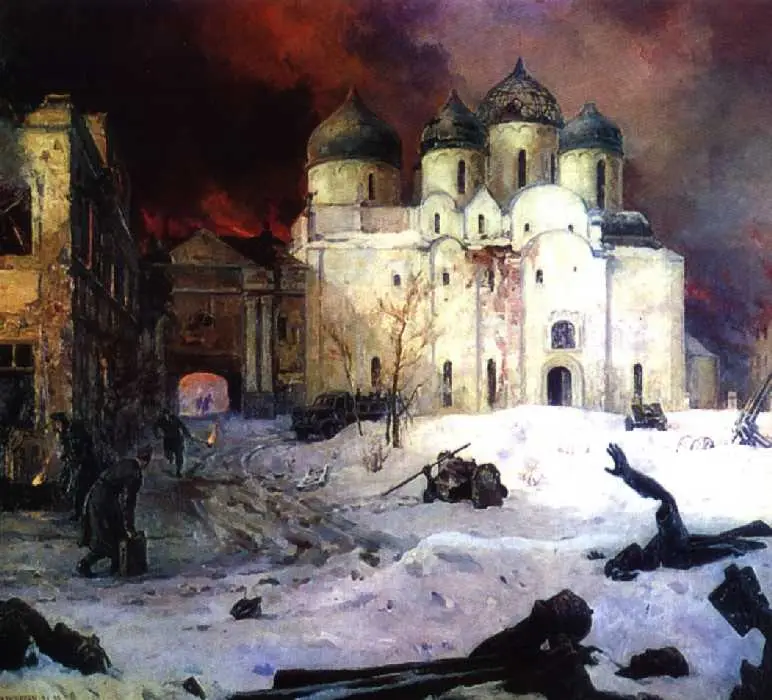
Painting “Flight of the Nazis from Novgorod”, Kukryniksy.
Information